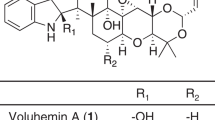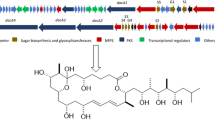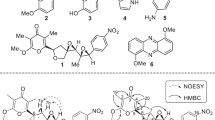Abstract
The structure of a new congener of chaetochromin, an inhibitor of triacylglycerol synthesis in CHO-K1 cells produced by Penicillium sp. FKI-4942, was elucidated by spectroscopic methods, including various NMR experiments. Isochaetochromin A1 has a bis-naphtho-γ-pyrone moiety.
Similar content being viewed by others
Introduction
During the course of screening for inhibitors of triacylglycerol synthesis in CHO-K1 cells, a new compound named isochaetochromin A1 was isolated along with structurally related known isochaetochromins B1 and B21 from the culture broth of Penicillium sp. FKI-4942. These compounds were found to inhibit triacylglycerol synthesis in CHO-K1 cells. The taxonomy of the producing fungus, fermentation, isolation and biological properties of isochaetochromins were described in a previous paper.2 In this study, the physico-chemical properties and structure elucidation of isochaetochromin A1 are described.
Materials and methods
General experimental procedures
UV spectra were recorded on a spectrophotometer (8453 UV-Visible spectrophotometer; Agilent Technologies, Santa Clara, CA, USA). IR spectra were recorded on a Fourier transform IR spectrometer (FT-710; Horiba, Kyoto, Japan). Optical rotations were measured with a digital polarimeter (DIP-1000; JASCO, Tokyo, Japan). CD spectra were measured with a spectrometer (J-720; JASCO). ESI-TOF-MS and HRESI-TOF-MS spectra were recorded on a mass spectrometer (JMS-T100LP; JEOL, Tokyo, Japan). Various NMR spectra were measured with a spectrometer (XL-400; Agilent Technologies, Santa Clara, CA, USA).
Results
Physico-chemical properties of isochaetochromins
The physico-chemical properties of isochaetochromins A1, B1 and B2 are summarized in Table 1 and have a similar pattern with absorption maxima at 234, 291–292 and 328 nm in the UV spectra. The IR absorption of isochaetochromins A1, B1 and B2 at 1342–1348, 1390, 1433–1448, 1635 and 3398–3425 cm−1 suggested the presence of carbonyl and hydroxy moieties in the molecule. These data indicated that isochaetochromin A1 is structurally related to isochaetochromins B1 and B2.
Structure of Isochaetochromin A1
The molecular formula of isochaetochromin A1 was determined to be C30H26O10 on the basis of HRESI-TOF-MS measurement (Table 1). The 13C NMR spectrum (CDCl3) showed 30 resolved signals, which were classified into four methyl carbons, four sp2 methine carbons, two sp3 methine carbons, two oxygenated sp3 methine carbons, eight sp2 quaternary carbons, eight oxygenated sp2 quaternary carbons and two carbonyl carbons by analysis of the distortionless enhancement by polarization transfer (DEPT) and 13C-1H HSQC spectra. The 1H NMR spectrum (CDCl3) displayed 24 proton signals, which were classified into 12 methyl protons, 8 methine protons and 4 hydroxy protons (δ 9.78, 9.94, 15.32 and 15.59). Taking the molecular formula into consideration, the presence of two more hydroxy protons was suggested. The connectivity of proton and carbon atoms was established by interpretation of the HSQC spectrum (Table 2). Analysis of 1H–1H COSY data revealed the presence of two partial structures, as shown in Figure 1. Furthermore, 13C–1H long-range couplings of 2J and 3J observed in the 13C–1H heteronuclear multiplet bond connectivity (HMBC) spectrum (Figure 2) provided further structural information: (1) the cross peaks from H-2 (δ 4.52) to C-4 (δ 202.6) and C-10a (δ 156.0), from H-3 (δ 2.64) to C-4 and C-4a (δ 101.5) and from 3-CH3 (δ 1.22) to C-4 supported the connectivity from 2-CH3 (δ 1.33) to C-4a. Considering the number of oxygen atoms present in isochaetochromin A1 and the chemical shifts of C-2 (δ 75.6) and C-10a, one oxygen atom should be inserted between these carbons. (2) The cross peaks from 5-OH (δ 15.59) to C-4a, C-5 (δ 165.6) and C-5a (δ 105.7), from 6-OH (δ 9.94) to C-5a, C-6 (δ 158.6) and C-7 (δ 100.1), from H-7 (δ 6.56) to C-5a, C-6, C-8 (δ 161.2) and C-9 (δ 102.3) and from H-10 (δ 6.14) to C-4a, C-5a, C-9, C-9a (δ 142.7) and C-10a supported the existence of the naphthalene ring (C-4a to C-10a). Considering the chemical shift of C-8 and molecular formula, one hydroxy group should be connected at C-8; thus, the existence of the naphtho-γ-pyrone (naphtho-γ-dihydropyrone) unit in isochaetochromin A1 was confirmed as shown in Figure 2. The NMR data suggested the presence of one more naphtho-γ-pyrone in isochaetochromin A1. Fortunately, the naphtho-γ-pyrone unit (C-2′ to C-10′a) was assigned in the same way as the first naphtho-γ-pyrone unit (C-2 to C-10a). Taking all these findings together, the planar structure of isochaetochromin A1 was elucidated to be a symmetrical dimer of the naphtho-γ-pyrone, as shown in Figure 3.
The relative stereochemistry at C-2, C-3, C-2′ and C-3′ of the γ-pyrone skeleton was investigated by the J values and NOE experiments. The J values (J2−3=3.0 Hz and J2′−3′=3.0 Hz) of isochaetochromin A1 indicated that both the vicinal methyl groups are cis.1 Furthermore, NOEs were observed between H-2 and H-3, between 2-CH3 and H-3, between H-3 and H-2/2-CH3, between H-2′ (δ 4.60) and H-3′ (δ 2.72)/3′-CH3 (δ 1.25), between H-3′ and H-2′ and between 3′-CH3 and H-2′ (Figure 4). From these data, the relative stereochemistry of isochaetochromin A1 was elucidated as shown in Figure 3.
To elucidate the absolute axial stereochemistry, the specific rotation and the CD data of isochaetochromin A1 was compared with those reported for isochaetochromins B1 and B2.1 The specific rotation of isochaetochromin A1 (−229°) showed a negative value, as did isochaetochromin B2 (−543.9°, aR), but isochaetochromin B1 (+142.6°, aS) showed a positive value. Furthermore, the CD spectrum of isochaetochromin A1 showed the first negative cotton effect at 292 nm and the second positive cotton effect at 268 nm. These spectra conformed to those of isochaetochromin B2. Accordingly, the respective absolute axis stereochemisitry of isochaetochromin A1 was elucidated to be aR.
Discussion
A new isomer named isochaetochromin A1 was isolated along with known isomers isochaetochromins B1 and B21 from the culture broth of Penicillium sp. FKI-4942 as inhibitors of TG synthesis in CHO-K1 cells.2 Isochaetochromins B1 and B2 were reported to be produced by Fusarium sp.,1 whereas all the isochaetochromins described in this study were produced by Penicillium sp.2
From the structure elucidation of isochaetochromins A1, B1 and B2, these compounds have the same planar structures, although the structural difference among the isomers comes from the combination of the stereochemistry at 2/2′ and 3/3′ methyl residues and from the 9/9′ axis (aS or aR) of the two monomers. Theoretically, there are 16 isomers for the same structure of this dimer. Among them, six isomers, chaetochromins A and B,3, 4 ustilaginoidin D6 and isochaetochromins A1, B1 and B21, 2 (Figure 3), have been reported so far. Chaetochromin A is a symmetrical dimer having two trans-2,3-dimethyl groups on the 5,6,8-trihydroxy-naphtho-γ-pyrone ring, and the absolute stereochemistry was established by CD and X-ray crystallography of p-bromobenzoate derivative.5 Ustilaginoidin D is also a symmetrical dimer having two trans-2,3-dimethyl groups, and the 9/9′ axial stereochemistry was elucidated to be aR by comparative CD spectroscopy. However, the absolute stereochemistry was not determined.6 On the other hand, chaetochromin B and isochaetochromins B1/B2 were unsymmetrical dimers having one trans-2,3-dimethyl group and one cis-2,3-dimethyl group, and these axial stereochemistries were elucidated to be aS, aS and aR by CD spectroscopy, respectively. However, it appeared difficult to elucidate the complete stereochemistry of these compounds. It would be done by X-ray crystallographic Analysis. In fact, the complete stereochemistry of chaetochromin B3 and isochaetochromins B1/B21 has not been reported to date.
This series of isomers was produced by fungal genera Chaetomium,3, 4, 7 Claviceps,6 Fusarium1 and Penicillium.2 As they were completely different in taxonomical characteristics, these fungi share the similar biosynthetic genes to produce naphtho-γ-pyrones. Distinct isomers will be further isolated from the culture broth of these fungi.
References
Singh, S. B. et al. Four novel bis-(naphtho-gamma-pyrones) isolated from Fusarium species as inhibitors of HIV-1 integrase. Bioorg. Med. Chem. Lett. 13, 713–717 (2003).
Ugaki, N. et al. New isochaetochromin, an inhibitor of triacylglycerol synthesis in mammalian cells, produced by Penicillium sp. FKI-4942: I. Taxonomy, fermentation, isolation and biological properties. J. Antibiot. 65, 15–19 (2012).
Koyama, K. & Natori, S. Chaetochromins B, C and D, bis(naphtho-γ-pyrone) derivatives from Chaetomium gracile. Chem. Pharm. Bull. 35, 578–584 (1987).
Sekita, S., Yoshihira, K. & Natori, S. Chaetochromin, a bis(naphthodihydropyran-4-one) mycotosin from Chaetomium thielavioideum: application of 13C-1H long-range coupling to the structure elucidation. Chem. Pharm. Bull. 28, 2428–2435 (1980).
Koyama, K., Natori, S. & Iitaka, Y. Absolute configurations of chaetochromin A and related bis(naphtho-δ-pyrone) mold metabolites. Chem. Pharm. Bull. 35, 4049–4055 (1987).
Koyama, K. & Natori, S. Further characterization of seven bis(naphtho-γ-pyrone) congeners of ustilaginoidins, coloring matters of Claviceps virens (Ustilaginoidea virens). Chem. Pharm. Bull. 36, 146–152 (1988).
Sekita, S. et al. Mycotoxin production by Chaetomium spp. and related fungi. Can. J. Microbiol. 27, 766–772 (1981).
Acknowledgements
We express our thanks to Ms N Sato for performing NMR experiments, and Dr K Nagai and Ms A Nakagawa for measuring mass spectra. This work was supported by a grant-in-aid for Scientific Research (B) 18390008 (to HT) from the Ministry of Education, Culture, Sports, Science and Technology of Japan.
Author information
Authors and Affiliations
Corresponding author
Rights and permissions
About this article
Cite this article
Ugaki, N., Yamazaki, H., Uchida, R. et al. New isochaetochromin, an inhibitor of triacylglycerol synthesis in mammalian cells, produced by Penicillium sp. FKI-4942: II. structure elucidation. J Antibiot 65, 21–24 (2012). https://doi.org/10.1038/ja.2011.106
Received:
Revised:
Accepted:
Published:
Issue Date:
DOI: https://doi.org/10.1038/ja.2011.106
Keywords
This article is cited by
-
Isochaetomium A2, a new bis(naphthodihydropyran-4-one) with antimicrobial and immunological activities from fungus Chaetomium microcephalum
Archives of Pharmacal Research (2014)
-
Aromatic polyketides from a sponge-derived fungus Metarhizium anisopliae mxh-99 and their antitubercular activities
Archives of Pharmacal Research (2013)
-
New isochaetochromin, an inhibitor of triacylglycerol synthesis in mammalian cells, produced by Penicillium sp. FKI-4942: I. Taxonomy, fermentation, isolation and biological properties
The Journal of Antibiotics (2012)







